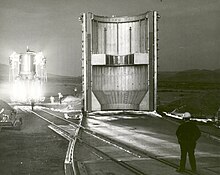

A nuclear thermal rocket (NTR) is a type of thermal rocket where the heat from a nuclear reaction replaces the chemical energy of the propellants in a chemical rocket. In an NTR, a working fluid, usually liquid hydrogen, is heated to a high temperature in a nuclear reactor and then expands through a rocket nozzle to create thrust. The external nuclear heat source theoretically allows a higher effective exhaust velocity and is expected to double or triple payload capacity compared to chemical propellants that store energy internally.
NTRs have been proposed as a spacecraft propulsion technology, with the earliest ground tests occurring in 1955. The United States maintained an NTR development program through 1973 when it was shut down for various reasons, including to focus on Space Shuttle development. Although more than ten reactors of varying power output have been built and tested, as of 2024[update], no nuclear thermal rocket has flown.[1]
Whereas all early applications for nuclear thermal rocket propulsion used fission processes, research in the 2010s has moved to fusion approaches. The Direct Fusion Drive project at the Princeton Plasma Physics Laboratory is one such example, although "energy-positive fusion has remained elusive". In 2019, the U.S. Congress approved US$125 million in development funding for nuclear thermal propulsion rockets.[1]
In May 2022 DARPA issued an RFP for the next phase of their Demonstration Rocket for Agile Cislunar Operations (DRACO) nuclear thermal engine program.[2] This follows on their selection, in 2021, of an early engine design by General Atomics and two spacecraft concepts from Blue Origin and Lockheed Martin. The next phases of the program will focus on the design, development, fabrication, and assembly of a nuclear thermal rocket engine.[3] In July 2023, Lockheed Martin was awarded the contract to build the spacecraft and BWX Technologies (BWXT) will develop the nuclear reactor. A launch is expected in 2027.[4][5]
- ^ a b Cite error: The named reference
unisci20190703was invoked but never defined (see the help page). - ^ "NASA, DARPA Will Test Nuclear Engine for Future Mars Missions - NASA". Retrieved 26 April 2024.
- ^ DARPA moving forward with development of nuclear powered spacecraft. DARPA News, 4 May 2022. URL: https://www.darpa.mil/news-events/2022-05-04
- ^ DARPA Kicks Off Design, Fabrication for DRACO Experimental NTR Vehicle. DARPA News, 26 July 2023. URL: https://www.darpa.mil/news-events/2023-07-26
- ^ "(Nu)clear the Way: The Future of Nuclear Propulsion is Here". Lockheed Martin. Retrieved 12 April 2024.